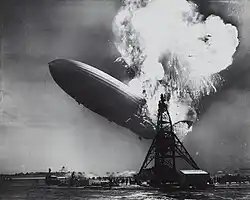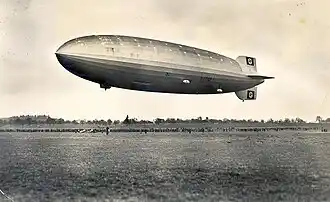
The Hindenburg disaster was an air travel disaster which occurred on the 6th of May 1937 at the Lakehurst Naval Air Station in Manchester Township in New Jersey in the United States. The disaster occurred when the Hindenburg zeppelin or airship caught fire around 7.25pm that evening while trying to dock at the air station. The cause of the accident is still not 100% clear, though it seems likely that a gas leak of the hydrogen used to float the airship was sparked into a huge fireball by some static electricity. 35 of the 97 people on board lost their lives, while a further victim on the ground was also killed. The disaster was widely publicized at the time and it is typically viewed as bringing the age of lighter-than-air travel to an end as considerable safety concerns arose about the use of airships.[1]
Research your ancestors on MyHeritage
The Hindenburg disaster chronology of eventsThe Hindenburg disaster chronology of events
The Hindenburg was an example of an airship or dirigible. Numerous individuals had begun experimenting with ways to fly as early as the seventeenth century. In those days the concept of lighter-than-air travel, whereby a gas that is less dense than air is burned to create buoyancy, was preferred as the means to do so. Using this method, hot-air balloons were developed from early in the eighteenth century and these soon evolved into the airships of the nineteenth century. These expanded on the concept of a hot air balloon, but created a much larger vessel with a metal frame draped in a huge balloon of sorts. With advances in the technology it became possible not just to rise up and down in the sky, but also to direct airships forwards. By the 1880s airships were becoming popular. They became known as zeppelins in Germany after Count Ferdinand von Zeppelin, a major pioneer in German airship technology.[2]

The Hindenburg zeppelin was named after Paul von Hindenburg. He had emerged as Germany’s foremost military commander during the First World War after winning a major victory early in the conflict against the Russians on the Eastern Front at the Battle of Tannenberg. On the strength of that he had become the Chief of the General Staff of the German imperial army in 1916 and was more powerful than Kaiser Wilhelm II in Germany in the last two years of the war. In 1925 he was elected as President of Germany and served as head of state down to his death in 1934. A class of airships, the Hindenburg-class, had been named in his honor when Luftschiffbau Zeppelin GmbH, Count von Zeppelin’s company, began developing them in the early 1930s.[3]

When it was completed in 1936 the LZ 129 Hindenburg was the largest airship ever built. The completed zeppelin was 245 meters long, 41 meters wide and could carry 70 passengers while being crewed by upwards of 60 people. These were enormous vessels by volume, roughly eight times the size of a modern long-haul airbus-type airplane. They also were quite luxurious ways to travel, with a dining room and lounge on board. It could also travel relatively fast by the standards of the time, with a cruising speed of 129 kilometers per hour. Significantly, the airship used hydrogen as the gas employed to raise the ship. The makers had planned on using helium, which is not flammable, in the understanding that it would be safer to do so, but they were forced into changing to hydrogen because of a virtual embargo on the use of helium airships in the United States under the terms of the Helium Control Act of 1927.[4]
The Hindenburg made several voyages in its first year in operation, mostly to the United States, though also to Brazil. On the 3rd of May 1937 it departed from the city of Frankfurt in Germany. There were 61 crew and 36 passengers on board and it was bound for the Lakehurst Naval Air Station in New Jersey. On the 6th of May it entered the Tristate area and passed over Manhattan. Zeppelins like the Hindenburg did not land so much as dock at their destinations. During the docking process shortly after 7pm on the evening of the 6th, some of the hydrogen cells began leaking, possibly exacerbated by poor weather conditions. A spark, most likely from static electricity, seems to have then ignited the gas and turned the Hindenburg into a giant fireball around 7.25pm, although the exact cause of the disaster is still debated today.[5]
There is footage of the disaster which attests to how the airship became rapidly enflamed and then fell crashing down on the airfield. Incredibly, out of the 97 people on board, only 35 lost their lives, even though it looked at the time as though no one could have survived the conflagration. Another individual on the ground was killed when the airship crashed. The disaster garnered huge international attention and concerns over the safety of airships brought the age of lighter-than-air travel to an end.[6]
Migratory and demographic impact of the Hindenburg disasterMigratory and demographic impact of the Hindenburg disaster

The Hindenburg disaster did not have any major migratory or demographic implications so far as people travelling between countries or relocating is concerned. Where it can be said to have had a tangible importance is the manner in which it changed air travel in the middle of the twentieth century. At that time aviation was still only in its adolescence. The first airplanes had been invented in the 1900s, but development thereafter was gradual. Charles Lindbergh was noted in 1927 for becoming the first person to fly non-stop from New York City to Paris. In such an environment zeppelins and airships were viewed as having a future role in air travel and air transport. The Hindenburg disaster brought that to an end. It was not simply the nature of the disaster, but the visceral images of the airship being turned into an enormous fireball which turned the world away from airships as a possible means of air travel. Moreover, rapid advances in airplane technology during the Second World War meant that airships were completely abandoned as a means of air travel.[7]
Hence, the tens of millions of people who have migrated by air since the 1940s have done so on airplanes, where in a different scenario airships might have had a role to play as well. Indeed, they may well do again in the near future. Numerous companies are investing large sums of money in launching a twenty-first century wave of airships, the belief being that they will offer a more sustainable form of air travel going forward, particularly in the sphere of cargo haulage. These include Flying Whales and Lighter Than Air Research, the latter backed by Google co-founder, Sergey Brin.[8]
See alsoSee also
Explore more about trans-Atlantic migrationExplore more about trans-Atlantic migration
- New York Castle Garden Immigrants records collection on MyHeritage
- Ellis Island and Other New York Passenger Lists, 1820-1957 records collection on MyHeritage
- The New York Gateway: Immigration, emigration and migration at Legacy Family Tree Webinars
- Tracing Immigrant Ancestors in New York Passenger Lists at Legacy Family Tree Webinars
- Ellis Island: How to Research Ancestors Who Passed Through the Gateway to Freedom at the MyHeritage Blog
References
- ↑ https://www.airships.net/hindenburg/disaster/
- ↑ Marc Mercado, ‘The Rise and Fall of Lighter-Than-Air Aircraft, 1783–1937’, in Legacy, Vol. 17, No. 1 (2017).
- ↑ Anna von der Goltz, Hindenburg: Power, Myth and the Rise of the Nazis (Oxford, 2009).
- ↑ https://edu.rsc.org/feature/what-ignited-the-hindenburg/2000137.article
- ↑ https://www.smithsonianmag.com/smithsonian-institution/80th-anniversary-hindenburg-disaster-mysteries-remain-180963107/
- ↑ https://www.history.com/news/hindenburg-disaster-zeppelin-crash-why
- ↑ https://www.historytoday.com/hindenburg-disaster-and-end-airship-era
- ↑ A new generation of airships is taking to the skies. CNN

